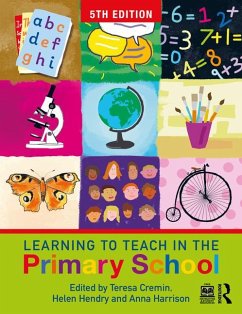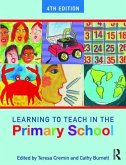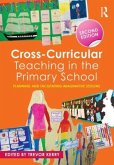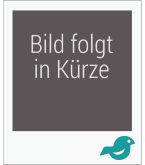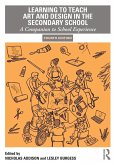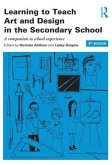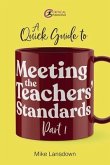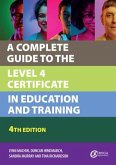Learning to Teach in the Primary School
Herausgeber: Harrison, Anna; Cremin, Teresa; Hendry, Helen
Learning to Teach in the Primary School
Herausgeber: Harrison, Anna; Cremin, Teresa; Hendry, Helen
- Broschiertes Buch
- Merkliste
- Auf die Merkliste
- Bewerten Bewerten
- Teilen
- Produkt teilen
- Produkterinnerung
- Produkterinnerung
The fifth edition of this bestselling textbook has been fully updated with the latest research and initiatives in the field, as well as the most recent curriculum and policy changes across the UK. It features two new co-editors and thirteen new chapters and enhanced accessibility throughout.
Andere Kunden interessierten sich auch für
![Learning to Teach in the Primary School Learning to Teach in the Primary School]() Learning to Teach in the Primary School48,99 €
Learning to Teach in the Primary School48,99 €![Cross-Curricular Teaching in the Primary School Cross-Curricular Teaching in the Primary School]() Cross-Curricular Teaching in the Primary School61,99 €
Cross-Curricular Teaching in the Primary School61,99 €![Maximising Learning in Physical Education Maximising Learning in Physical Education]() Maximising Learning in Physical Education35,99 €
Maximising Learning in Physical Education35,99 €![Learning to Teach Art and Design in the Secondary School Learning to Teach Art and Design in the Secondary School]() Learning to Teach Art and Design in the Secondary School28,99 €
Learning to Teach Art and Design in the Secondary School28,99 €![Learning to Teach Art and Design in the Secondary School Learning to Teach Art and Design in the Secondary School]() Learning to Teach Art and Design in the Secondary School74,99 €
Learning to Teach Art and Design in the Secondary School74,99 €![A Quick Guide to Meeting the Teachers' Standards Part 1 A Quick Guide to Meeting the Teachers' Standards Part 1]() Mike LansdownA Quick Guide to Meeting the Teachers' Standards Part 131,99 €
Mike LansdownA Quick Guide to Meeting the Teachers' Standards Part 131,99 €![A Complete Guide to the Level 4 Certificate in Education and Training A Complete Guide to the Level 4 Certificate in Education and Training]() Lynn MachinA Complete Guide to the Level 4 Certificate in Education and Training39,99 €
Lynn MachinA Complete Guide to the Level 4 Certificate in Education and Training39,99 €-
-
-
The fifth edition of this bestselling textbook has been fully updated with the latest research and initiatives in the field, as well as the most recent curriculum and policy changes across the UK. It features two new co-editors and thirteen new chapters and enhanced accessibility throughout.
Produktdetails
- Produktdetails
- Learning to Teach in the Primary School Series
- Verlag: Taylor & Francis Ltd
- 5 ed
- Seitenzahl: 618
- Erscheinungstermin: 30. Juni 2025
- Englisch
- Abmessung: 190mm x 246mm x 36mm
- Gewicht: 1390g
- ISBN-13: 9781032691756
- ISBN-10: 1032691751
- Artikelnr.: 72543932
- Herstellerkennzeichnung
- Libri GmbH
- Europaallee 1
- 36244 Bad Hersfeld
- gpsr@libri.de
- Learning to Teach in the Primary School Series
- Verlag: Taylor & Francis Ltd
- 5 ed
- Seitenzahl: 618
- Erscheinungstermin: 30. Juni 2025
- Englisch
- Abmessung: 190mm x 246mm x 36mm
- Gewicht: 1390g
- ISBN-13: 9781032691756
- ISBN-10: 1032691751
- Artikelnr.: 72543932
- Herstellerkennzeichnung
- Libri GmbH
- Europaallee 1
- 36244 Bad Hersfeld
- gpsr@libri.de
Teresa Cremin is Professor of Education (Literacy) at The Open University, UK and Co-Director of the Centre for Literacy and Social Justice. She has served as President of the UKRA and UKLA, and as Board member of BookTrust, The Reading Agency and the Poetry Archive. Her research focuses on volitional reading and writing, creative pedagogies and teachers' literate identities (https://ourfp.org/). Helen Hendry is a Senior Lecturer in Primary Education at The Open University, UK and Co-Director of the Centre for Literacy and Social Justice. Her recent research focuses on teacher professional development for reading, informal book talk in the early years, and reading and writing for pleasure. Anna Harrison is a Senior English Lecturer in ITE at Roehampton University, UK. Her research interests are young children's engagement as readers and children's literature within education. Her current PhD research at Cambridge University is focused on a newer area within children's family literacy of siblings as independent peer to peer readers.
SECTION 1 - BECOMING A TEACHER
1.1 Primary teaching: The editors' perspective
1.2 Becoming a professional in the current context
1.3 Capitalizing on professional practice: making most of your placements
SECTION 2 - EXPLORING THE NATURE OF LEARNING AND TEACHING
2.1 Looking at children
2.2 Building on firm foundations: Early years practice
2.3 Revisiting ideas around learning and teaching
2.4 Developing as a professional
SECTION 3 - PLANNING AND MANAGING LEARNING
3.1 Building inclusive communities of engaged learners
3.2 Lesson planning: thinking beyond the template
3.3 Organising Your Classroom and Using Technology for Learning
3.4 Managing classroom behaviour
3.5 Addressing Social, Emotional, Mental Health and Behaviour Needs
3.6 Organising effective classroom talk
3.7 The value of outdoor learning
SECTION 4 - APPROACHING THE CURRICULUM
4.1 Critical perspectives on the curriculum
4.2 Reading: Developing a rich reading curriculum
4.3 Writing: Teaching the craft of writing
4.4 Mathematics: Teaching mathematics: what, how and why
4.5 Science: The science curriculum
4.6 Arts: An arts-enriched curriculum
4.7 Humanities: Teaching the humanities
SECTION 5 - ASSESSMENT
5.1 Assessment for learning: Formative approaches
5.2 Assessment and learning: Summative approaches
SECTION 6 - DIVERSITY AND INCLUSION
6.1 Understanding and Implementing Adaptive Teaching
6.2 Special educational needs and inclusion
6.3 Teaching for social justice: Creating equity for pupils living in
poverty and those from black and minority ethnic backgrounds
6.4 Responding to cultural diversity and citizenship
6.5 Responding to linguistic diversity
6.6 Gender Matters: respectful approaches to gender equity in primary
school
SECTION 7 - WIDER CURRICULUM ASPECTS
7.1 Listening to Pupils: Developing mutually respectful teacher-pupil
relationships to enhance pupils' learning
7.2 Creativity and creative teaching and learning
7.3 Teaching Thinking: developing children's thinking skills and
metacognition
7.4 Mental Health and Wellbeing in Initial Teacher Education
7.5 Sustainability and Climate Change Education
7.6 Primary education in a digital age
SECTION 8 - PARTNERSHIP IN PRACTICE
8.1 Working effectively with teaching assistants
8.2 Partnerships with parents
8.3 Understanding the teacher's pastoral role
SECTION 9 - YOUR PROFESSIONAL DEVELOPMENT
9.1 Ready, Steady, Teach..
9.2 Understanding and planning your continuing professional development
9.3 Research and professional learning: Using research and enquiry to
develop practice through asking 'What If?', 'What else?' and 'What for?' as
well as 'What might work?'
1.1 Primary teaching: The editors' perspective
1.2 Becoming a professional in the current context
1.3 Capitalizing on professional practice: making most of your placements
SECTION 2 - EXPLORING THE NATURE OF LEARNING AND TEACHING
2.1 Looking at children
2.2 Building on firm foundations: Early years practice
2.3 Revisiting ideas around learning and teaching
2.4 Developing as a professional
SECTION 3 - PLANNING AND MANAGING LEARNING
3.1 Building inclusive communities of engaged learners
3.2 Lesson planning: thinking beyond the template
3.3 Organising Your Classroom and Using Technology for Learning
3.4 Managing classroom behaviour
3.5 Addressing Social, Emotional, Mental Health and Behaviour Needs
3.6 Organising effective classroom talk
3.7 The value of outdoor learning
SECTION 4 - APPROACHING THE CURRICULUM
4.1 Critical perspectives on the curriculum
4.2 Reading: Developing a rich reading curriculum
4.3 Writing: Teaching the craft of writing
4.4 Mathematics: Teaching mathematics: what, how and why
4.5 Science: The science curriculum
4.6 Arts: An arts-enriched curriculum
4.7 Humanities: Teaching the humanities
SECTION 5 - ASSESSMENT
5.1 Assessment for learning: Formative approaches
5.2 Assessment and learning: Summative approaches
SECTION 6 - DIVERSITY AND INCLUSION
6.1 Understanding and Implementing Adaptive Teaching
6.2 Special educational needs and inclusion
6.3 Teaching for social justice: Creating equity for pupils living in
poverty and those from black and minority ethnic backgrounds
6.4 Responding to cultural diversity and citizenship
6.5 Responding to linguistic diversity
6.6 Gender Matters: respectful approaches to gender equity in primary
school
SECTION 7 - WIDER CURRICULUM ASPECTS
7.1 Listening to Pupils: Developing mutually respectful teacher-pupil
relationships to enhance pupils' learning
7.2 Creativity and creative teaching and learning
7.3 Teaching Thinking: developing children's thinking skills and
metacognition
7.4 Mental Health and Wellbeing in Initial Teacher Education
7.5 Sustainability and Climate Change Education
7.6 Primary education in a digital age
SECTION 8 - PARTNERSHIP IN PRACTICE
8.1 Working effectively with teaching assistants
8.2 Partnerships with parents
8.3 Understanding the teacher's pastoral role
SECTION 9 - YOUR PROFESSIONAL DEVELOPMENT
9.1 Ready, Steady, Teach..
9.2 Understanding and planning your continuing professional development
9.3 Research and professional learning: Using research and enquiry to
develop practice through asking 'What If?', 'What else?' and 'What for?' as
well as 'What might work?'
SECTION 1 - BECOMING A TEACHER
1.1 Primary teaching: The editors' perspective
1.2 Becoming a professional in the current context
1.3 Capitalizing on professional practice: making most of your placements
SECTION 2 - EXPLORING THE NATURE OF LEARNING AND TEACHING
2.1 Looking at children
2.2 Building on firm foundations: Early years practice
2.3 Revisiting ideas around learning and teaching
2.4 Developing as a professional
SECTION 3 - PLANNING AND MANAGING LEARNING
3.1 Building inclusive communities of engaged learners
3.2 Lesson planning: thinking beyond the template
3.3 Organising Your Classroom and Using Technology for Learning
3.4 Managing classroom behaviour
3.5 Addressing Social, Emotional, Mental Health and Behaviour Needs
3.6 Organising effective classroom talk
3.7 The value of outdoor learning
SECTION 4 - APPROACHING THE CURRICULUM
4.1 Critical perspectives on the curriculum
4.2 Reading: Developing a rich reading curriculum
4.3 Writing: Teaching the craft of writing
4.4 Mathematics: Teaching mathematics: what, how and why
4.5 Science: The science curriculum
4.6 Arts: An arts-enriched curriculum
4.7 Humanities: Teaching the humanities
SECTION 5 - ASSESSMENT
5.1 Assessment for learning: Formative approaches
5.2 Assessment and learning: Summative approaches
SECTION 6 - DIVERSITY AND INCLUSION
6.1 Understanding and Implementing Adaptive Teaching
6.2 Special educational needs and inclusion
6.3 Teaching for social justice: Creating equity for pupils living in
poverty and those from black and minority ethnic backgrounds
6.4 Responding to cultural diversity and citizenship
6.5 Responding to linguistic diversity
6.6 Gender Matters: respectful approaches to gender equity in primary
school
SECTION 7 - WIDER CURRICULUM ASPECTS
7.1 Listening to Pupils: Developing mutually respectful teacher-pupil
relationships to enhance pupils' learning
7.2 Creativity and creative teaching and learning
7.3 Teaching Thinking: developing children's thinking skills and
metacognition
7.4 Mental Health and Wellbeing in Initial Teacher Education
7.5 Sustainability and Climate Change Education
7.6 Primary education in a digital age
SECTION 8 - PARTNERSHIP IN PRACTICE
8.1 Working effectively with teaching assistants
8.2 Partnerships with parents
8.3 Understanding the teacher's pastoral role
SECTION 9 - YOUR PROFESSIONAL DEVELOPMENT
9.1 Ready, Steady, Teach..
9.2 Understanding and planning your continuing professional development
9.3 Research and professional learning: Using research and enquiry to
develop practice through asking 'What If?', 'What else?' and 'What for?' as
well as 'What might work?'
1.1 Primary teaching: The editors' perspective
1.2 Becoming a professional in the current context
1.3 Capitalizing on professional practice: making most of your placements
SECTION 2 - EXPLORING THE NATURE OF LEARNING AND TEACHING
2.1 Looking at children
2.2 Building on firm foundations: Early years practice
2.3 Revisiting ideas around learning and teaching
2.4 Developing as a professional
SECTION 3 - PLANNING AND MANAGING LEARNING
3.1 Building inclusive communities of engaged learners
3.2 Lesson planning: thinking beyond the template
3.3 Organising Your Classroom and Using Technology for Learning
3.4 Managing classroom behaviour
3.5 Addressing Social, Emotional, Mental Health and Behaviour Needs
3.6 Organising effective classroom talk
3.7 The value of outdoor learning
SECTION 4 - APPROACHING THE CURRICULUM
4.1 Critical perspectives on the curriculum
4.2 Reading: Developing a rich reading curriculum
4.3 Writing: Teaching the craft of writing
4.4 Mathematics: Teaching mathematics: what, how and why
4.5 Science: The science curriculum
4.6 Arts: An arts-enriched curriculum
4.7 Humanities: Teaching the humanities
SECTION 5 - ASSESSMENT
5.1 Assessment for learning: Formative approaches
5.2 Assessment and learning: Summative approaches
SECTION 6 - DIVERSITY AND INCLUSION
6.1 Understanding and Implementing Adaptive Teaching
6.2 Special educational needs and inclusion
6.3 Teaching for social justice: Creating equity for pupils living in
poverty and those from black and minority ethnic backgrounds
6.4 Responding to cultural diversity and citizenship
6.5 Responding to linguistic diversity
6.6 Gender Matters: respectful approaches to gender equity in primary
school
SECTION 7 - WIDER CURRICULUM ASPECTS
7.1 Listening to Pupils: Developing mutually respectful teacher-pupil
relationships to enhance pupils' learning
7.2 Creativity and creative teaching and learning
7.3 Teaching Thinking: developing children's thinking skills and
metacognition
7.4 Mental Health and Wellbeing in Initial Teacher Education
7.5 Sustainability and Climate Change Education
7.6 Primary education in a digital age
SECTION 8 - PARTNERSHIP IN PRACTICE
8.1 Working effectively with teaching assistants
8.2 Partnerships with parents
8.3 Understanding the teacher's pastoral role
SECTION 9 - YOUR PROFESSIONAL DEVELOPMENT
9.1 Ready, Steady, Teach..
9.2 Understanding and planning your continuing professional development
9.3 Research and professional learning: Using research and enquiry to
develop practice through asking 'What If?', 'What else?' and 'What for?' as
well as 'What might work?'

